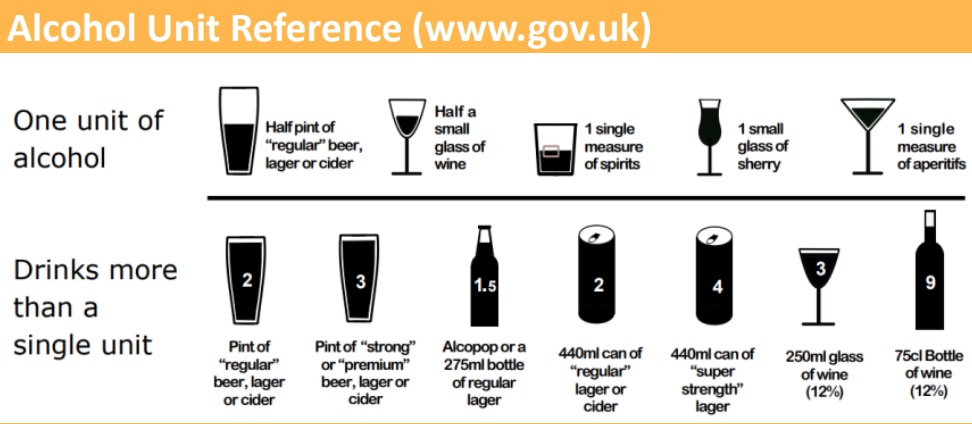Download and print as a PDF (236kB pdf)
On this page
- Alcohol Unit Reference
- What is alcohol withdrawal?
- What should I do if I go into alcohol withdrawal?
- Where do I start?
- Download and print a drinking diary
- How do I reduce my drinking?
- Tips to help you cut down on drinking
- Are there any warning signs to look out for?
- Further resources for information and advice
Alcohol Unit Reference

What is alcohol withdrawal?
If you start to feel unwell after going several hours without a drink, this means that you could be dependent on alcohol and may go into alcohol withdrawal. Signs of alcohol withdrawal include:
- shaking
- sweating
- nausea (feeling sick)
- headache.
Alcohol withdrawal can have serious complications, like confusion, seeing or hearing things (hallucinations) and seizures. It can even be fatal if left untreated.
What should I do if I go into alcohol withdrawal?
If you are experiencing symptoms do not stop drinking suddenly. Your goal should be to gain some control of your drinking and cut down gradually. Try to space out your drinks to manage your withdrawal symptoms.
Be Aware
If you have previously had seizures or experienced hallucinations (seeing or hearing things) when trying to come off alcohol, please get professional help from your alcohol support team before trying to cut down at home. Due to your risk of alcohol withdrawal, you will need extra help.
Where do I start?
Reducing your alcohol intake is a really effective way to improve your health, boost your energy, lose weight and save money. Any reduction in the amount you drink every week will be beneficial.
Start with a drinking diary. Write down each drink you have, and find out how many units it has in it. Start measuring your drinks if you are drinking from a bottle of spirits or wine.
Unit calculators are easily available on the internet or via phone apps. Alternatively, the % (percentage) alcohol on the side of the bottle or can represents the number of units in one litre. There is a reference for unit calculations on the front of this leaflet.
Download and print a drinking diary
You can download and print a drinking diary here. (60kB pdf)
How do I reduce my drinking?
Try to space out your drinks, particularly in the middle of the day. Aim for a stable daily alcohol intake that is planned. Once you have done this for one week, start to cut down slowly.
Aim to cut down by 10% every four days.
If you start to experience withdrawal symptoms, this means you are cutting down too quickly. Increase your daily alcohol intake to a level where you do not have these symptoms. Aim to keep this steady for one week. After that, try to cut down by 10% every week.
Tips to help you cut down on drinking
- If you can, ask another adult to help you: if they can help to measure, monitor and keep the alcohol, it will be easier for you.
- Change to a lower strength drink: for example, replace one can of your high strength lager with a standard strength lager.
- Measure out your drinks.
- Add water or a mixer to drinks, or alternate soft drinks with alcohol.
- Pay attention to your diet: limit sugar intake, eat wholemeal bread and brown rice to make sure you have enough thiamine (vitamin B1).
- If you have been prescribed them, take your thiamine tablets three times a day, every day.
- Keep well hydrated by drinking lots of water.
- Seek the help of community alcohol support teams such as Change Grow Live (CGL) or Alcoholics Anonymous (AA) (see further down page).
Are there any warning signs to look out for?
Call an ambulance if you:
- have a seizure
- become confused
- start to see or hear things which don’t exist (hallucinations)
- develop double vision
- become unsteady on your feet.
If you live with anyone, tell them to be aware of these signs too, so they can call an ambulance for you if you can’t.
Further resources for information and advice
Change Grow Live
Local alcohol and drugs advice service.
Phone
01273 731900
Email
www.changegrowlive.org
NHS.uk website
ru-ok? Young people’s substance misuse advice
My DrinkAware app
The Smartphone App enables you to calculate units and track your progress.
Be Aware
If you were given benzodiazepines (chlordiazepoxide, diazepam, Valium) before your discharge from A&E, you should not drive, or operate machinery, for at least 72 hours and until symptom-free. Please remember not to drive under the influence of alcohol or drugs.
This leaflet is intended for patients receiving care in Brighton & Hove or Haywards Heath.
The information in this leaflet is for guidance purposes only and is in no way intended to replace professional clinical advice by a qualified practitioner.